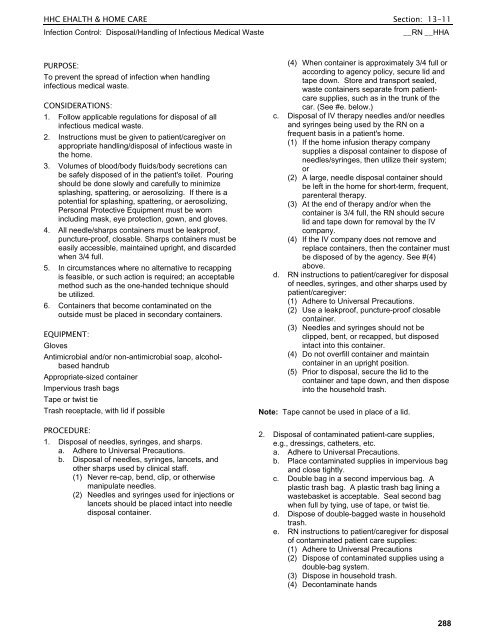HHC Health & Home Care Clinical Policy And
HHC Health & Home Care Clinical Policy And
HHC Health & Home Care Clinical Policy And
Create successful ePaper yourself
Turn your PDF publications into a flip-book with our unique Google optimized e-Paper software.
<strong>HHC</strong> EHALTH & HOME CARE Section: 13-11<br />
Infection Control: Disposal/Handling of Infectious Medical Waste __RN __HHA<br />
PURPOSE:<br />
To prevent the spread of infection when handling<br />
infectious medical waste.<br />
CONSIDERATIONS:<br />
1. Follow applicable regulations for disposal of all<br />
infectious medical waste.<br />
2. Instructions must be given to patient/caregiver on<br />
appropriate handling/disposal of infectious waste in<br />
the home.<br />
3. Volumes of blood/body fluids/body secretions can<br />
be safely disposed of in the patient's toilet. Pouring<br />
should be done slowly and carefully to minimize<br />
splashing, spattering, or aerosolizing. If there is a<br />
potential for splashing, spattering, or aerosolizing,<br />
Personal Protective Equipment must be worn<br />
including mask, eye protection, gown, and gloves.<br />
4. All needle/sharps containers must be leakproof,<br />
puncture-proof, closable. Sharps containers must be<br />
easily accessible, maintained upright, and discarded<br />
when 3/4 full.<br />
5. In circumstances where no alternative to recapping<br />
is feasible, or such action is required; an acceptable<br />
method such as the one-handed technique should<br />
be utilized.<br />
6. Containers that become contaminated on the<br />
outside must be placed in secondary containers.<br />
EQUIPMENT:<br />
Gloves<br />
Antimicrobial and/or non-antimicrobial soap, alcoholbased<br />
handrub<br />
Appropriate-sized container<br />
Impervious trash bags<br />
Tape or twist tie<br />
Trash receptacle, with lid if possible<br />
PROCEDURE:<br />
1. Disposal of needles, syringes, and sharps.<br />
a. Adhere to Universal Precautions.<br />
b. Disposal of needles, syringes, lancets, and<br />
other sharps used by clinical staff.<br />
(1) Never re-cap, bend, clip, or otherwise<br />
manipulate needles.<br />
(2) Needles and syringes used for injections or<br />
lancets should be placed intact into needle<br />
disposal container.<br />
(4) When container is approximately 3/4 full or<br />
according to agency policy, secure lid and<br />
tape down. Store and transport sealed,<br />
waste containers separate from patientcare<br />
supplies, such as in the trunk of the<br />
car. (See #e. below.)<br />
c. Disposal of IV therapy needles and/or needles<br />
and syringes being used by the RN on a<br />
frequent basis in a patient's home.<br />
(1) If the home infusion therapy company<br />
supplies a disposal container to dispose of<br />
needles/syringes, then utilize their system;<br />
or<br />
(2) A large, needle disposal container should<br />
be left in the home for short-term, frequent,<br />
parenteral therapy.<br />
(3) At the end of therapy and/or when the<br />
container is 3/4 full, the RN should secure<br />
lid and tape down for removal by the IV<br />
company.<br />
(4) If the IV company does not remove and<br />
replace containers, then the container must<br />
be disposed of by the agency. See #(4)<br />
above.<br />
d. RN instructions to patient/caregiver for disposal<br />
of needles, syringes, and other sharps used by<br />
patient/caregiver:<br />
(1) Adhere to Universal Precautions.<br />
(2) Use a leakproof, puncture-proof closable<br />
container.<br />
(3) Needles and syringes should not be<br />
clipped, bent, or recapped, but disposed<br />
intact into this container.<br />
(4) Do not overfill container and maintain<br />
container in an upright position.<br />
(5) Prior to disposal, secure the lid to the<br />
container and tape down, and then dispose<br />
into the household trash.<br />
Note: Tape cannot be used in place of a lid.<br />
2. Disposal of contaminated patient-care supplies,<br />
e.g., dressings, catheters, etc.<br />
a. Adhere to Universal Precautions.<br />
b. Place contaminated supplies in impervious bag<br />
and close tightly.<br />
c. Double bag in a second impervious bag. A<br />
plastic trash bag. A plastic trash bag lining a<br />
wastebasket is acceptable. Seal second bag<br />
when full by tying, use of tape, or twist tie.<br />
d. Dispose of double-bagged waste in household<br />
trash.<br />
e. RN instructions to patient/caregiver for disposal<br />
of contaminated patient care supplies:<br />
(1) Adhere to Universal Precautions<br />
(2) Dispose of contaminated supplies using a<br />
double-bag system.<br />
(3) Dispose in household trash.<br />
(4) Decontaminate hands<br />
288







